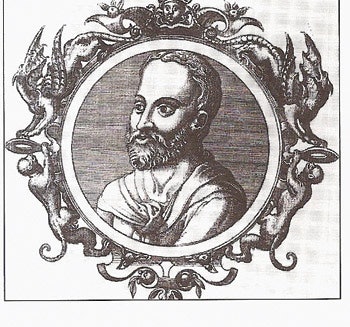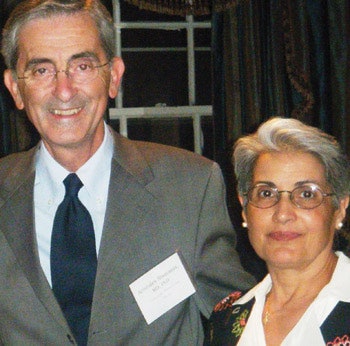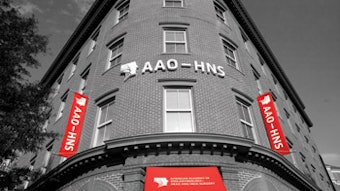OHS: Hospitals and Otolaryngology in the Byzantine Era
Aristides Sismanis, MD Past-president, Otolaryngology Historical Society The Byzantine era (AD 330-1453) is misunderstood and often overshadowed by the history of ancient Greece and Rome. Recent research, however, has revealed that Byzantium played a significant role in the evolution of Western civilization, including the medical field. The early adoption of Christianity as the official religion of the state provided the proper environment for addressing the needs of the sick. Between the years AD 400 and 1204, there was remarkable development of hospitals. Monastic documents, or typika, give significant information on the bylaws, organization, and structure of Byzantine hospitals. Aristides Sismanis, MD, past president, Otolaryngology Historical Society, now professor and department chair, Hippokration Hospital, Athens, Greece, with Mrs. Sismanis. A typical hospital was a square building with a central fireplace surrounded by four pillars, which supported a cupola with vents to release the smoke. Four aisles of sickbeds were connected to the central part of the building. In the 12th century, the Pantocrator Hospital of Constantinople had 50 beds organized in five ordinoi (wards). Five beds were surgical, five medical, eight ophthalmological/intestinal, 12 gynecologic, and 20 general. The Emperor Manuel I Komnenos, or Kaloioanis, (AD 1143-1180) was a physician himself and practiced in the Pantocrator hospital. Some of his subjects had the opportunity to receive treatment from their Emperor! Since the official language of the state was Greek, physicians had easy access and comprehension of Hippocrates’ and Galen’s treatises. In otolaryngology, Byzantine physicians made contributions that were significant for their time. Oribasius of Pergamon (AD 320–400), a personal physician of the Emperor Julian the Apostate, describes reconstruction of the pinna and nose in his book About Colobomas of the Nose and Ear. Aetius of Amida (AD 527-564), chief physician of Emperor Justinian, wrote 16 books on medical practice. For cleaning the ear canal, he recommends irrigation with otochytes (a type of syringe) or with milotris (cotton tip applicator). His description of tonsillectomy is rather clear and detailed. He describes removal of foreign bodies from the respiratory and upper digestive tracts, as well as management of thyroid lesions. Alexander of Tralles (AD 525-605), brother of the famous architect Anthemius, who built the church of Hagia Sophia in Constantinople, described a type of trumpet inserted in the ear canal for hearing improvement. Paul of Aegina (AD 625-690) excelled in surgery. He published seven books describing tonsillectomy, laryngotomy, and thyroid procedures. For lateral atresia of the ear, he recommends excision with scolopomachairio (scalpel); however, for medial atresia, he suggests caution. He also describes techniques for reconstruction of colobomas of the ear and lips: “We remove the cicatricial area and after undermining the flaps of the skin we bring them together and suture.” Bibliography The Birth of the Hospital in the Byzantine Empire. Timothy S. Miller, The Johns Hopkins University Press, 1997. Constantinople and the West. Deno John Geanakoplos. The University of Wisconsin Press, 1989. Biographical Dictionary of the Byzantine Empire. Donald M. Nicol, B. A. Seaby, Ltd, London, 1991. Medical Byzantine Manuscripts. Medical School of Athens, 1995. Physicians of Byzantium. Aristotelis Eftihiadis. Kathimerini newspaper, October 12, 1999.
 Paul of Aegina, a 7th-century Byzantine Greek physician and surgeon, author of the medical encyclopedia Medical Compendium in Seven Books, unrivaled in its accuracy and completeness.
Paul of Aegina, a 7th-century Byzantine Greek physician and surgeon, author of the medical encyclopedia Medical Compendium in Seven Books, unrivaled in its accuracy and completeness.Aristides Sismanis, MD
Past-president, Otolaryngology Historical Society
The Byzantine era (AD 330-1453) is misunderstood and often overshadowed by the history of ancient Greece and Rome. Recent research, however, has revealed that Byzantium played a significant role in the evolution of Western civilization, including the medical field.
The early adoption of Christianity as the official religion of the state provided the proper environment for addressing the needs of the sick. Between the years AD 400 and 1204, there was remarkable development of hospitals. Monastic documents, or typika, give significant information on the bylaws, organization, and structure of Byzantine hospitals.

Since the official language of the state was Greek, physicians had easy access and comprehension of Hippocrates’ and Galen’s treatises. In otolaryngology, Byzantine physicians made contributions that were significant for their time. Oribasius of Pergamon (AD 320–400), a personal physician of the Emperor Julian the Apostate, describes reconstruction of the pinna and nose in his book About Colobomas of the Nose and Ear.
Aetius of Amida (AD 527-564), chief physician of Emperor Justinian, wrote 16 books on medical practice. For cleaning the ear canal, he recommends irrigation with otochytes (a type of syringe) or with milotris (cotton tip applicator). His description of tonsillectomy is rather clear and detailed. He describes removal of foreign bodies from the respiratory and upper digestive tracts, as well as management of thyroid lesions.
Alexander of Tralles (AD 525-605), brother of the famous architect Anthemius, who built the church of Hagia Sophia in Constantinople, described a type of trumpet inserted in the ear canal for hearing improvement. Paul of Aegina (AD 625-690) excelled in surgery. He published seven books describing tonsillectomy, laryngotomy, and thyroid procedures. For lateral atresia of the ear, he recommends excision with scolopomachairio (scalpel); however, for medial atresia, he suggests caution. He also describes techniques for reconstruction of colobomas of the ear and lips: “We remove the cicatricial area and after undermining the flaps of the skin we bring them together and suture.”
Bibliography
- The Birth of the Hospital in the Byzantine Empire. Timothy S. Miller, The Johns Hopkins University Press, 1997.
- Constantinople and the West. Deno John Geanakoplos. The University of Wisconsin Press, 1989.
- Biographical Dictionary of the Byzantine Empire. Donald M. Nicol, B. A. Seaby, Ltd, London, 1991.
- Medical Byzantine Manuscripts. Medical School of Athens, 1995.
- Physicians of Byzantium. Aristotelis Eftihiadis. Kathimerini newspaper, October 12, 1999.













